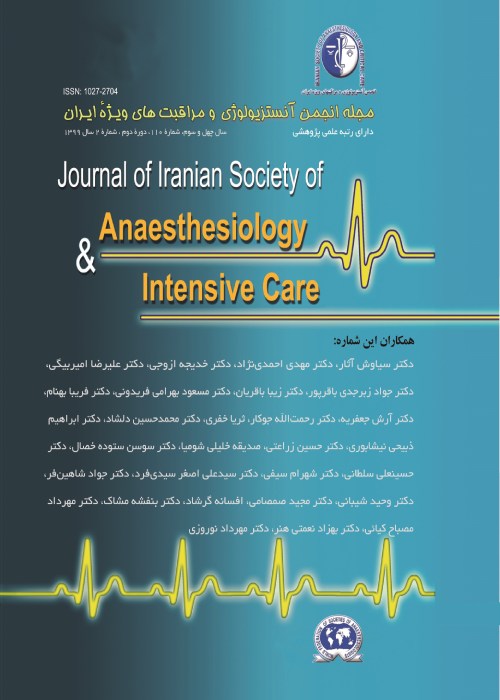Comparison between prevalence of ventilator-associated pneumonia based on previous and new surveillance definitions of Centers for Disease Control and Prevention in intensive care units
Author(s):
Article Type:
Research/Original Article (دارای رتبه معتبر)
Abstract:
Introduction
Ventilator-associated pneumonia is One of complication of mechanical ventilation and Its diagnosis in surveillance system based on the judgments of clinical, causing a large difference in reporting it. Centers for Disease Control and Prevention(CDC)has used objectively measures(ventilator-associated events) to overcome these barriers. Considering that in Iran, for surveillance system and reporting ventilator-associated pneumonia in hospitals, as well as from previous surveillance definitions of CDC are used ,and the new surveillance definitions (VAE) are supposed to replace the previouse surveillance definitions in Iran, this study was conducted to compare ventilator-associated pneumonia based on previous and new surveillance definitions of CDC.Materials And Methods
In order to do this prospective study, Information on surveillance system in 4 intensive care units during 1 month were collected. The diagnosis of ventilator-associated pneumonia with CDC previous definitions (PNEU1) based on radiographic finding and clinical signs or symptomes(cnange in temperature,change in white blood cell count,altered mental status,change in respiratory secretions,cough or dyspnea,rales and worsening gas exchanges) and ventilator-associated events (VAE) based on daily minimum PEEP or FIO2, change in temperature,change in white blood cell count,start of new antimicrobial agent and culture of respiratory secretions,lung tissue,pleural fluid or lung histopathology. Results
12 Ventilator-associated pneumonia during a month in which all of them were PNEU1. Ventilator- Associated Events, in 6 cases (50%) were seen; 2(33%) were Infection-related Ventilator-Associated Complication(IVAC) and 4 (67%) were Possible Ventilator Associated Pneumonia (PVAP). ventilator associated events revealed about half of the cases of ventilatorassociated pneumonia. McNemar non-parametric test showed no significant difference between the two methods (P = NS), obtained content of the agreement between the two methods using the Kappa was 0.656. Conclusion
In our study, VAE surveillance detected half of VAP cases, but there was no statistically significant difference between the two methods which may be due to the small number of pneumonia cases and short duration of study. Also,given that the new surveillance definitions are supposed to be in place of the previous definitions in Iran and this, requires the accurate recording and daily monitoring of PEEP or FIO2 in the manual chart of intensive care units and requires a sufficient number of trained personel .the operation of Ventilator Associated Pneumonia based on the new surveillance definitions of CDC,requires further study in Iran. Language:
Persian
Published:
Iranian Journal Of Anaesthesiology and Critical Care, Volume:39 Issue: 1, 2017
Pages:
20 to 28
magiran.com/p1790995
دانلود و مطالعه متن این مقاله با یکی از روشهای زیر امکان پذیر است:
اشتراک شخصی
با عضویت و پرداخت آنلاین حق اشتراک یکساله به مبلغ 1,390,000ريال میتوانید 70 عنوان مطلب دانلود کنید!
اشتراک سازمانی
به کتابخانه دانشگاه یا محل کار خود پیشنهاد کنید تا اشتراک سازمانی این پایگاه را برای دسترسی نامحدود همه کاربران به متن مطالب تهیه نمایند!
توجه!
- حق عضویت دریافتی صرف حمایت از نشریات عضو و نگهداری، تکمیل و توسعه مگیران میشود.
- پرداخت حق اشتراک و دانلود مقالات اجازه بازنشر آن در سایر رسانههای چاپی و دیجیتال را به کاربر نمیدهد.
In order to view content subscription is required
Personal subscription
Subscribe magiran.com for 70 € euros via PayPal and download 70 articles during a year.
Organization subscription
Please contact us to subscribe your university or library for unlimited access!


